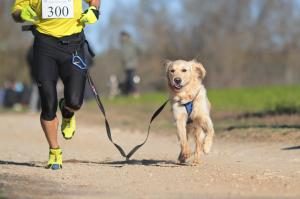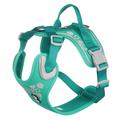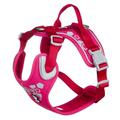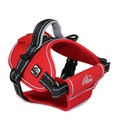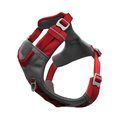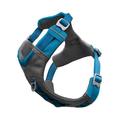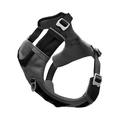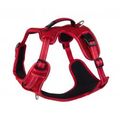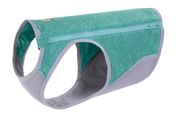Put simply, canicross is cross-country running, but with humans and dogs. With a harness attaching your dog to your middle, you run together as part of a team. With voice commands given from behind, it is your job to guide your dog in the right direction.
Is it suitable for all dogs?
As long as your dog is fit, healthy and willing to take part, you can enjoy Canicross with any dog and any breed, although some will be much more suited to it than others.
Larger, working breeds are typically the preferred breed to Canicross with, while smaller breeds tend to struggle more with distance. It is important to listen to your dog and take note of any signs they’re not adjusting to or enjoying the sport.
If you have any worries whatsoever, speak to your vet. It is worth doing this before you embark on Canicross training.
Where to run?
As it’s a cross-country sport, the best places to run are off-road locations such as woodland parks and forest trails. When training your dog in Canicross, make sure you train over a variety of different terrains, including hard and soft ground.
Both you and your dog will enjoy the change of scene and it will help to keep your dog engaged.
How do you direct your dog?
You can find lots of advice on this online and terms will vary depending on who you ask/where you look. So long as you are consistent and your dog understands, it isn’t overly important which words or terms you use.
A lot of Canicrossers use words like:
‘Forward’
‘Go right’ or ‘go gee’
‘Go left’ or ‘go haw’
‘On by’ (ignore and keep going)
‘With me’/’heel’/’here’ (run alongside me)
‘Easy’ (when slowing down)
To start with, your dog will follow the other dogs running with you and go in the same direction, so use these words as you go to help them make the connection.
What gear do I need?
Harness – there are many different types of sport harness on the market, so do your research and find the one that’s most suitable for your dog. The key thing is how comfortable the harness is, so ensure it fits well and doesn’t restrict your dog in any way. The lungs need to be able to expand fully, so ideally choose a harness that doesn’t cover the ribs.
Lines – a bungee-style leash is best as it will help absorb shock for both you and your dog. Length is also key, as you don’t want to be tripping over it or running into your dog. The ideal line length is 2 metres at full stretch.
Belts – you need to be able to run with your hands free, so a strong and secure waist or hip belt is crucial. This will comfortably take the pull of your dog without toppling you, and faster runners with heavier dogs should also be secured with leg straps to maintain the runner in the upright position.
If your dog is working or highly active, you might consider opting for a working dog food to ensure they're getting everything they need to stay healthy and active. If unsure, speak to your vet or a canine nutritionist for advice. You can also contact the manufacturers of working dog foods who should be able to talk you through it.
If you have any experience of Canicross or want to give it a go, comment below to start a discussion! We hope this blog has been helpful and if you have any questions, feel free to ask them :)
Written by: Hannah
